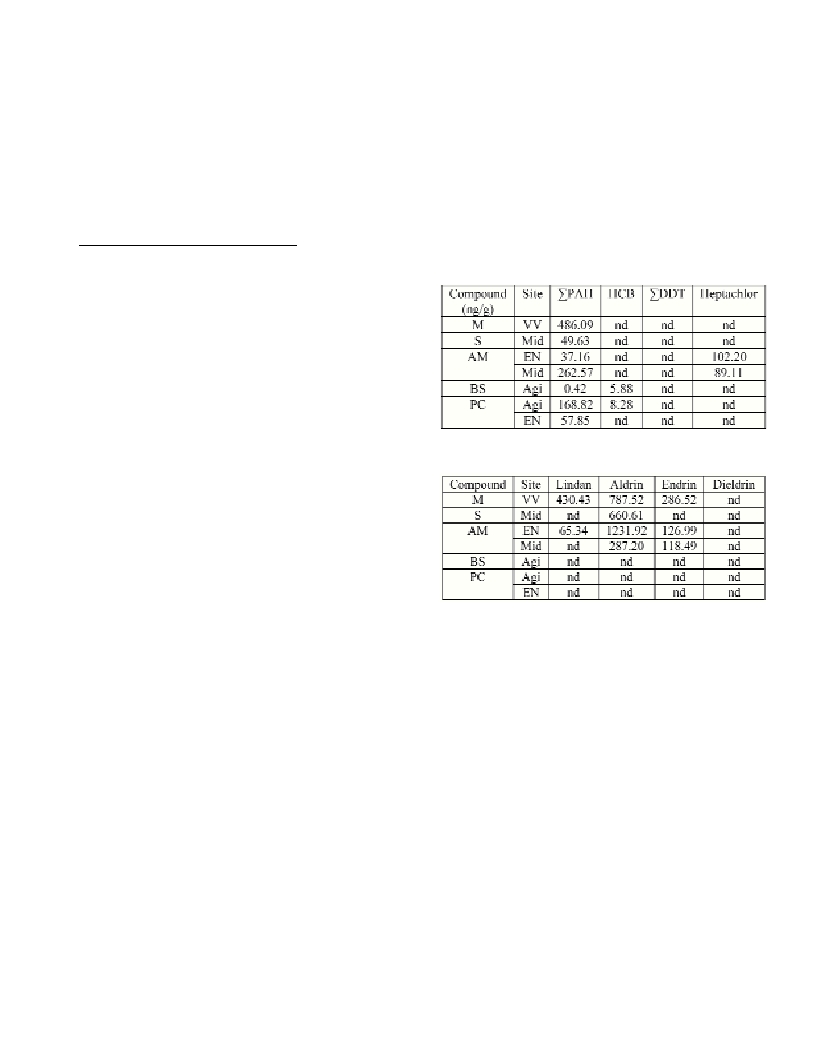ORGANOCHLORINE PESTICIDES AND PAHS COMPOUNDS OCCURRENCE IN MUSSEL
AND FISH LIVER FROM BLACK SEA
Simona Dobrinas
1*
, Valentina Coatu
2
, Elisabeta Chirila
1
1
Department of Chemistry, University “Ovidius” of Constantza, 124, Mamaia Blvd., 700, Constantza, Romania,
* sdobrinas@univ-ovidius.ro
2
National Institute of Marine Researches and Development “Grigore Antipa”, Bd Mamaia 300, 700, Constantza, Romania
Abstract
A method has been studied for the analysis of 9 POPs and 15 PAHs in mussel and fish liver from the Black Sea. The method was based
on liquid-liquid extraction using n-hexane. The extracts were fractionated and cleaned up with a Florisil, respectively aluminium oxide and
silica gel column. The concentrations of analytes were determined by gas chromatography with electron capture detection (GC-ECD),
respectively bygas chromatography with mass spectrometer detector (GC–MS).
Keywords: POPs, PAHs, GC-ECD, GC-MS
Rapp. Comm. int. Mer Médit., 37,2004
188
Introduction
Many persistent, bioaccumulated POPs have been extensively used
in many countries, but nowadays their use has been prohibited.
Compounds such as DDT and diendrin have become globally
enriched in food chains (1-3).
PAHs are widespread environmental contaminants and represent a
very important group of chemical carcinogens (4). So, these pollutants
pose a threat to human beings and aquatic organisms (5).
This study aims to evaluate the ocurrence of important organic
contaminants, such as POPs and PAHs in biota (mussle and fish)
collected from the Black Sea.
Sampling
Mussels’species samples (Mytilus sp.-MandScapharca sp.-S)
were collected from two different locations on the Romanian Black
Sea coast (Midia -Mid and Vama Veche -VV). Fish species samples
(Apollonia melanostomus -AM, Ponticola cephalargoides -PC,
Blennius sanguinolentus -BS) were collected from three different
locations in the Black Sea (Midia -Mid, Eforie Nord- EN and Agigea
-Agi). All samples were collected in 2002. The samples were wrapped
in polyetylene bags and frozen at 4
o
C.
A 5-10 g amount of fish and mussel liver was homogenized with
anhydrous Na
2
SO
4
and extracted with n-hexane in a Soxhlet device.
Extraction
The extracts were filtered and concentrated by rotary evaporator. In
order to separate the PAHs, an aliquot of the extract was applied to 5
g of activated aluminium oxide and silica-gel column, respectively 5
g of activated Florisil column for POPs, topped with 1 cm of
anhydrous sodium sulfate, which was pre-washed with n-hexane. The
columns were eluted with n-hexane-dichlormethane (3:1). Each
fraction was concentrate to 1 mL using the Kuderna – Danish
concentrator. The concentrated aliquot was blown down with
nitrogen, the internal standards (9,10 dihidroanthracene and
trichlorobiphenyl) were added, and the final volume was injected.
Instrumental analysis
A HP 5890 gas chromatograph equipped with an electron capture
detector (ECD) was used for POPs analysis. The separation was
performed on a fused–silica capillary column HP–5,
30m
×
0.32mm
×
0.25
µ
m film thickness.
PAHs analyses were performed using a HP5890 gas chromatograph
interfaced to a HP5972 mass selective detector (6). The analyses were
operated in SIM mode. Identification was made on the basis of
matching the mass spectrum and the retention time of the compound
to that of a known standard.
Results and discussion
Concentrations of POPs and PAHs measured in mussel and fish
liver from Black Sea are given in Table 1 and Table 2. It can be
observed that PAHs are the main contaminants in all samples. Aldrin
was found at high levels, while HCB and heptachlor concentrations
were low.
For fishes collected from the same location (Eforie Nord) it could
be seen that AM contained higher amount of pollutants.
These analyses indicate that levels of HCB are much lower than
concentrations measured in fishes from Danube Delta (7) and DDT
was not detected comparatively with samples from Sea of Japan (8).
Table 1. Concentrations of PAHs and some POPs in the Black Sea biota.
Table 2. Concentrations of some POPs in the Black Sea biota.
References
1-Duke T.W., 1977. Pesticides in aquatic environments and overview.
Plenum Press, New York, 257 p.
2-Connor L., Johnson M.S., Copplestone D., Leah R.T., 2001. Recent
trends in organochlorine residues in mussles (Mytilus edulis) from the
Mersey Estuary. Mar. Environ. Res., 52: 397-411.
3-Garcia L.M., Porte C., albaiges J., 2000. Organochlorine pollutants and
xenobiotic metabolizing enzymes in W. mediteranean mesopelagic fish.
Mar. Poll. Bulletin, 40:764-768.
4-Cooke M., Dennis A.J., 1986. Polynuclear aromatic hydrocarbons:
chemistry, characterisation and carcinogenisis. Battle Press, Columbus,
Ohio.
5-Adamo R.D., Pelosi S., Trotta P., Sansone G., 1997. Bioaccumulation
and biomagnification of polycyclic aromatic hydrocarbons in aquatic
organisms. Mar. Chem., 56: 45-49.
6-Dobrinas S., Coatu V., Chitimiea S.C., 2002. Gas chromatography
utilization for the pesticides determination in marine water. Rev.Chim
(Bucharest), 53: 630-633.
7-Covaci A., Gheorghe A., Hulea O., Schepens P., 2002. Levels of
organohalogenated pollutants in biota from the Danube Delta, Romania.
Organohalogen Compounds, 59: 11.
8-Syasina I.G., 2003. POPs in fish and mollusks from the lower reaches
of the Tumen River and the adjacent areas of Peter the Great Bay, the Sea
of Japan. Biologya Morya, 29: 34-40.

